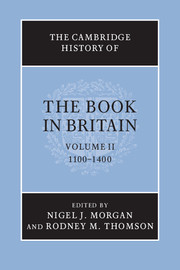1 - Books and society
from The roles of books
Published online by Cambridge University Press: 28 November 2008
Summary
There is a late Stone Age civilization known to modern archaeologists as the ‘Beaker People’ from the survival of large numbers of its distinctive clay pots. If a Beaker Person were to meet a modern prehistorian, he would probably be astonished and distressed to learn of his people’s sobriquet and he would draw attention to their fine textiles, woodwork, painting, music, religion, language and poetry. Beakers, he would say, were only a small and not even central part of their culture. However, the name is applied simply because fragments of the indestructible pottery have survived and all the rest has vanished.
The question, then, is whether we are in danger of over-estimating the place of books in medieval society, simply because the books survive when so much else from England of c.1100–c.1400 has disappeared. Illuminated manuscripts are among the most famous and enduring relics of the Middle Ages. Thousands of English books from the period under discussion still exist, far more than any other moveable artefacts, easily and widely accessible now, and it is appealing to think of feudal England as a time when beautiful manuscripts must have been a visible and familiar part of daily life. Victorian Gothic and Arthurian paintings show illuminated books in profusion. In practice, very few medieval people ever came face to face with the pages of manuscripts. Their ownership was restricted to a very small fraction of the population, disproportionately well-documented, and most men and women of medieval England probably passed their lives without ever reading or even touching a book.
- Type
- Chapter
- Information
- The Cambridge History of the Book in Britain , pp. 1 - 21Publisher: Cambridge University PressPrint publication year: 2008
References
- 2
- Cited by



